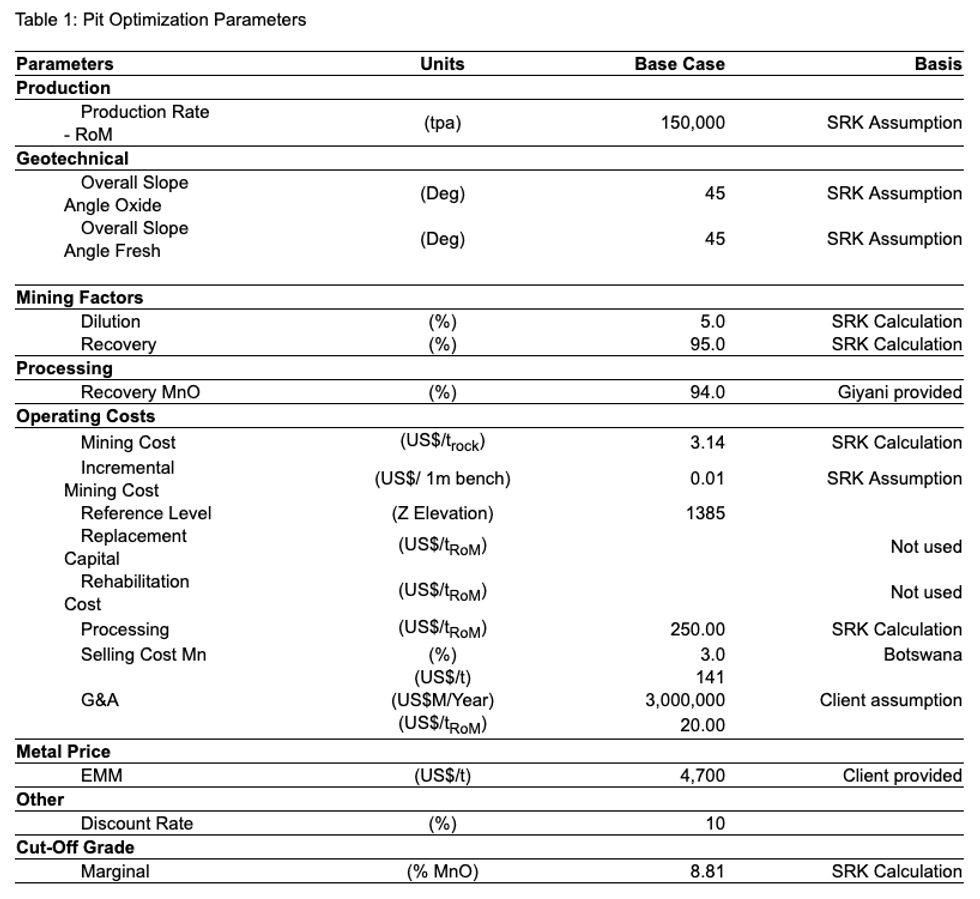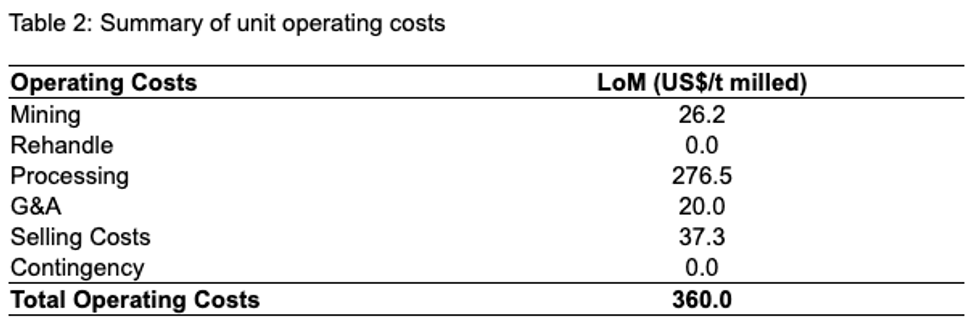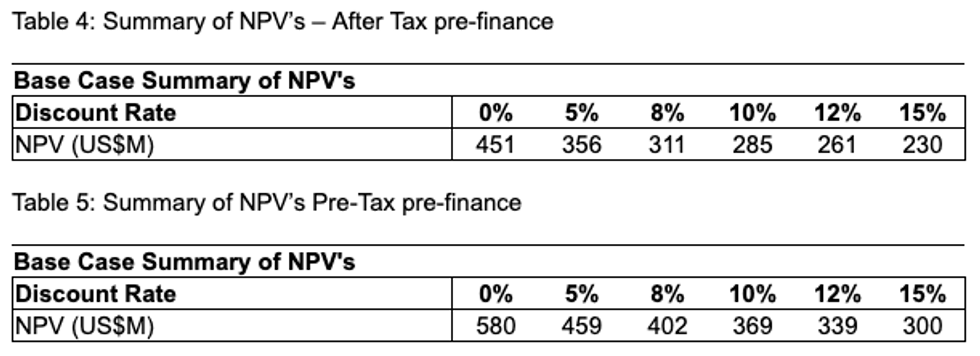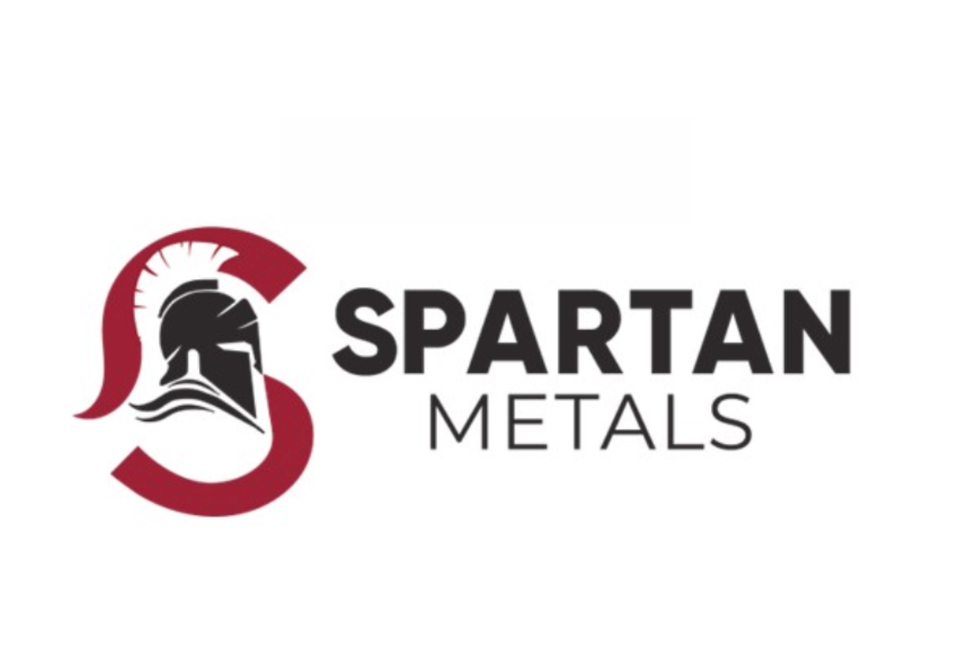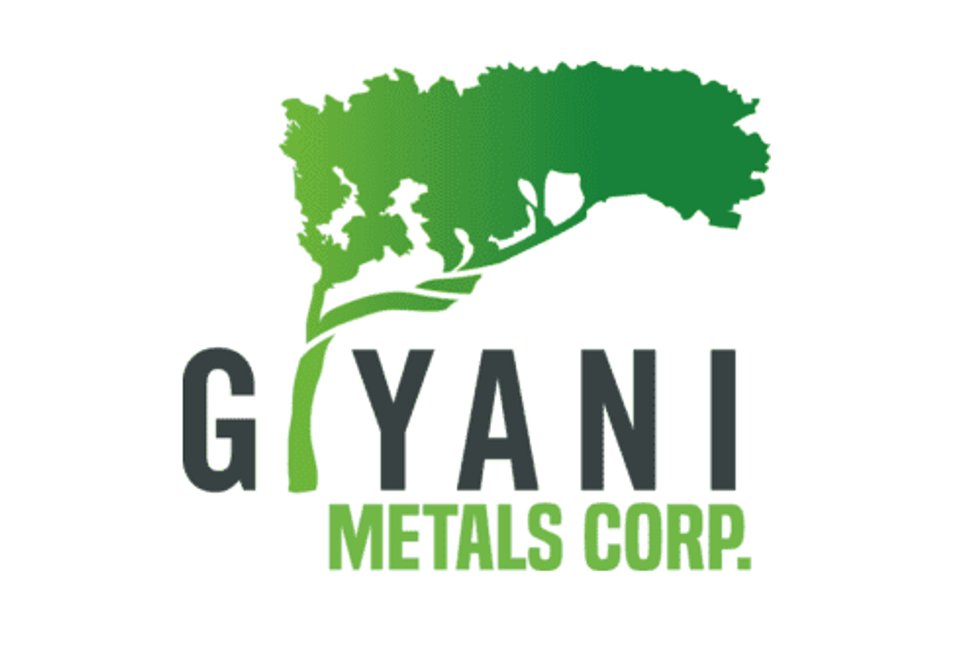Giyani Announces Positive PEA Results for its K.Hill Manganese Project in Botswana with an After-Tax Net Present Value of C$379 Million (US$285 Million)
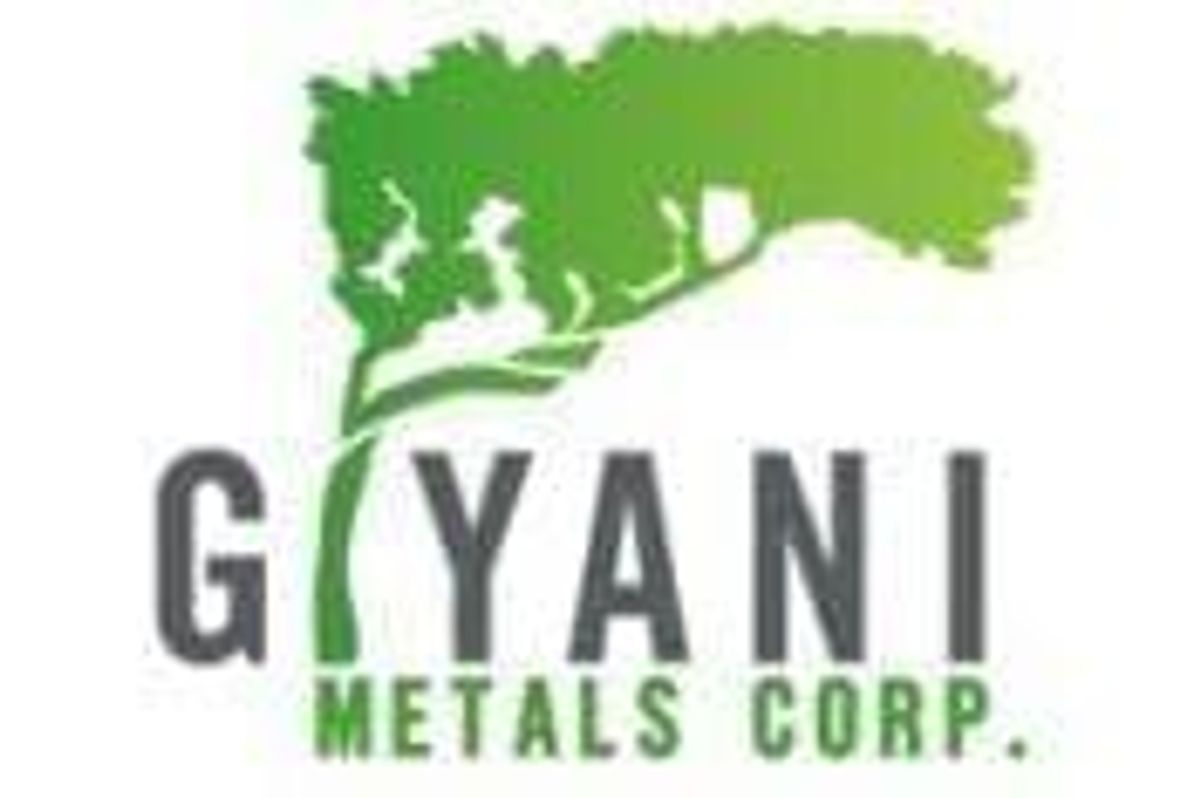
Giyani Metals Corp. (TSXV:EMM) is pleased to announce the results of the preliminary economic assessment for its K.Hill manganese project.
Giyani Metals Corp. (TSXV:EMM) (FRANKFURT:KT9) (WKN:A2DUU8) (“Giyani” or the “Company”) is pleased to announce the results of the preliminary economic assessment (“PEA”) for its K.Hill manganese project.
Robin Birchall, CEO of Giyani Metals Corp. commented:
“We are extremely pleased with the completion of the PEA for K.Hill, our first deposit in Botswana, and we are even more delighted with the findings of this report which demonstrates the strong economic potential of the K.Hill manganese project. Our immediate next steps are to continue hydrometallurgical testing with electro-refining to produce high purity EMM samples for testing by battery makers. We will move forward with a definitive feasibility study in order to upgrade K.Hill into a mineral reserve through a targeted reserve drilling campaign, and ultimately develop a mine plan for the K.Hill project.”
Highlights:
- PEA based on the 1.1 million tonnes inferred mineral resource estimate that the Company announced on September 28, 2018
- 9-year potential project operating life producing 245,000 tonnes of high-purity electrolytic manganese metal (“HPEMM”)
- Pre-tax NPV of C$491 million (US$369 million) and after tax NPV of C$379 million (US$285 million), using a 10% discount rate
- Estimated C$144.4 million (US$108.5 million) in pre-production capital, C$13.2 million (US$9.9 million) in sustaining capital, C$23.7 million (US$17.8 million) in contingency at 15%, and C$6.7 million (US$5 million) closure costs for a total project capital of C$188 million (US$141.3 million)
- After-tax IRR of 90.6% and a 1.5 year payback period
- Project economics are based on a projected average price of US$4,700/tonne for HPEMM of 99.9% Mn over the project life
- Access to established logistics chain and infrastructure in a well-developed and mining friendly jurisdiction
- Initial attractive project economics and growing market demand for battery-grade manganese products should attract multiple offers of project financing from the mining investment community
- Opportunities exist to improve returns through further enhancement of K.Hill mineral resources into a mineral reserve and the addition of other deposits within the greater Giyani licence area including the existing Otse and Lobatse deposits
- Immediate next steps: continue hydrometallurgical testing with electro-refining to produce HPEMM samples for testing by battery makers and upgrade K.Hill into a mineral reserve through a targeted reserve drilling campaign and a feasibility study
- Further next steps: commence environmental impact assessment and feasibility study in preparation for the mine permit application in 2020
The PEA was undertaken by SRK Consulting (UK) Limited (“SRK”), with metallurgical testwork and design input from Lab 4 Inc. (“Lab4”), a metallurgy consulting firm managed by Dr. Ian Flint, the Department of Geology of Dalhousie University and the Minerals Engineering Centre of Dalhousie University, all in Halifax, Nova Scotia, Canada. The PEA is also based on an inferred mineral resource estimate as detailed in the NI 43-101 report prepared by MSA Group (Pty) Ltd. (“MSA”) in November 2018. An updated NI 43-101 Technical Report on the K.Hill manganese project including results of the PEA will be filed on SEDAR within 45 days of the issuance of this news release and made available on the Company’s website.
The PEA is considered preliminary in nature and includes inferred mineral resources that are considered too speculative geologically to have the economic considerations applied to them that would enable them to be categorized as mineral reserves, and accordingly there is no certainty that the preliminary economic assessment will be realized. The expected accuracy of costs in the PEA are within a -35% to +45% level of confidence, as is appropriate for the level of study and accuracy of the input data provided. Mineral Resources that are not Mineral Reserves do not by definition have demonstrated economic viability.
Summary of PEA Results
The following sections are extracted from the SRK PEA document.
Mining
The envisaged mining method for the K.Hill Project is traditional truck and shovel. Due to the low processing throughput, and reasonable strip ratio, the volume of total material moved (TMM) is easily manageable. For the mining part of the PEA, the key tasks that were undertaken are listed below.
- Analysis of the geological model and adaptation for mine planning purposes
- Definition of key operating cost components, revenue and applicable royalties
- Open pit optimization to generate a pit shell
- Practical design of the pit including ramp access
- Practical waste dump design
- Layout of haul roads
- Generation of a mining schedule, including pushbacks
- Equipment calculations to determine fleet requirements
- Determination of mining fleet based on similar operations worldwide
The pit optimization parameters are shown in Table 1 and are discussed below.
The mining cost was calculated based on the S&P database for published 2018 mining costs for similar small-scale mining operations around the world, as well as a similar-sized SRK client operation in Africa.
Dilution and recovery were estimated based on similar results achieved using relatively small scale equipment. It is anticipated that an efficient operation of the project may improve project economics.
The processing recovery used in the pit optimization was based on initial results from the metallurgical test work on leaching. Processing costs are elevated due to the electrowinning and electrorefining processes. Separation of the Mn requires significant electricity, estimated at 6,800 kWh/tonne processed.
The sale price of US$4,700/t has been assumed for a 99.9% HPEMM product.
Giyani estimates that the project should be able to operate comfortably at a G&A operating cost of US$3M/yr. The royalty in Botswana from the sale of manganese is 3%.
Figure 1 shows the total material movement by Cutback on a quarterly basis
Figure 1: Total Material movement by Cutback on a quarterly basis:
https://www.globenewswire.com/NewsRoom/AttachmentNg/13b19400-4e47-44b6-b2d3-a8b44cca4ad3
Figure 2 shows run of mine tonnage to plant split by Cutback by quarter
Figure 2: Run of mine tonnage to plant split by Cutback by quarter:
https://www.globenewswire.com/NewsRoom/AttachmentNg/da11c7b9-644b-4bdb-9f08-91ec97ff25a5
The mining schedule for total movement is shown in Figure 3 below
Figure 3: Total Material Movement:
https://www.globenewswire.com/NewsRoom/AttachmentNg/83f96d39-431c-4c05-875c-dc4d0ec8b76c
Based on the work undertaken in the PEA the following key conclusions are made:
- The mining of the K.Hill deposit is a relatively straightforward affair, with no known or expected issues
- Mining equipment, maintenance and support services to the mining operation are easily obtained in the local region and are easily brought to site
- The site has good access to quality infrastructure
- No blasting is anticipated to be required, but a hydraulic breaker will need to be used to break the breccia cap
- A relatively small mining fleet will be able to deal with the required volumes that need to be moved
- A relatively light labour crew is required
Metallurgy and Mineral Processing
A simplified block diagram for the proposed process for the production of electrolytic manganese metal is shown in Figure 4
Figure 4: Process Block Diagram:
https://www.globenewswire.com/NewsRoom/AttachmentNg/fb923611-62ce-4987-94f8-88b340803824
Comminution
The comminution circuit will consist of several stages of crushing and grinding to achieve the target grind size, which is a P80 of 200 mm subject to further optimization.
Leaching
Leaching will be undertaken in a series of open topped tanks. The test work indicates a total leach residence time of two hours. Filtered solids from the comminution circuit will be mixed with barren electrolyte returned from the EW stage, with reagent sulphuric acid added to meet the target acid strength (260 g/l based on the test work), as well as the reductant sucrose, which is consumed during the leach reaction.
Liquid/Solid Separation
A vacuum belt filter is envisaged for the solid / liquid separation between leaching and solvent extraction (SX). This stage will incorporate a cake washing stage, in order to both acquire maximum soluble Mn recovery, and to minimize the residual acid content of the filter cake.
Solvent Extraction (SX)
The filtrate from the leaching stage will be subjected to SX for impurity removal. The SX circuit will consist of one or more extraction stages, one or more stripping stages, plus washing / scrubbing stage/s as appropriate.
Purified electrolyte from the SX circuit will be advanced to the EW circuit. Raffinate will be recycled internally within the SX circuit. A bleed stream of raffinate will be removed for water balance and impurity (principally Ca and Mg) removal purposes. As part of the bleed stream treatment, a manganese-containing precipitate will be produced, which will be recycled to the leach or extraction circuits to minimize Mn losses.
Electrowinning
Manganese metal will be recovered from the purified solution from SX by electrowinning. Due to the particular electrochemical behaviour of manganese, the EW cells will be configured with a membrane to separate the anodic and cathodic reaction zones.
Electrorefining
In order to produce high purity (>99.7%) Electrolytic Manganese Metal (EMM), a second stage of electrorefining is required. The grades of the first stage EMM is typically suitable for electrorefining in halide-based solutions. The final product EMM will be produced in typical flake form.
Based on the scoping level work completed for this assignment, SRK concludes the following:
- There is a viable process route for the proposed EMM product
- Further detailed test work is required to support the product specification, recoveries, operating costs, plant flow sheets and capital cost estimation
Financial Evaluation
The following general assumptions have been applied to the Technical Economic Model (“TEM”) for the Project:
- is expressed in real terms
- is presented at 2019 money terms for Net Present Value (NPV) calculation purposes;
- applies a Base Case discount rate of 10%
- is based on long term manganese prices of US$4,700 /t for a 99.9% HPEMM product
- is expressed in after-tax and pre-financing terms and assumes 100% equity
- Giyani’s tax advisers have indicated that they consider it likely that a flat Botswanan corporate tax rate of 22% can be applied, accordingly a base corporate tax rate of 22% has been used
- selling costs have been approximated at 3.0% of revenue
- for tax purposes, capital investments are depreciated immediately, and unredeemed capital is carried forward indefinitely as permitted for mining projects in Botswana.
Table 2 below summarizes the expected capital costs based on the PEA
Total capital costs are estimated to be US$141.3M over the Life of Project. Mining capital costs are estimated at US$3.6M. Processing capital costs amount to US$95.9M. Infrastructure capital amounts to US$6.3M. Sustaining capital and closure cost provisions amount to US$9.3M and US$5M respectively. Contingency has been included at 15% and amounts to US$17.7M. Table 3 summarizes the capital costs over the Project life.
Net Present Value
The NPV of the cash flows are shown in Tables 4 and 5 using discount rates from 0% to 15% in an after-tax and pre-tax context. At a discount rate of 10%, the after-tax NPV for the Project is US$285M.
Conclusion
Based on the work carried out for the PEA, SRK concludes the following:
- The Project reflects a positive NPV of US$285M at a 10% discount rate. Further investment and technical studies are therefore warranted
- Average operating costs have been estimated at US$360/t milled
- Total capital expenditure has been estimated at US$141.3M
- The Project NPV is most sensitive to revenue (grade or commodity price) but has lower sensitivity to operating costs and is least sensitive to capital costs
- The Project critically depends on achieving production of a HPEMM product. If this grade of product cannot be achieved, the value of the saleable product falls significantly
Qualified Persons / NI 43-101 Statements
The Qualified Person (as that term is defined by National Instrument 43-101) responsible for preparing the PEA for the K.Hill manganese project is Michael John Beare, BEng, CEng, MIOM of SRK Consulting (UK) Ltd. Mr. Beare has reviewed and approved the scientific and technical content contained in this press release and verified the underlying technical data. Mr. Beare is independent of the Company.
Hydrometallurgical testwork was performed on three samples taken from drill cores extracted from the K.Hill deposit during the Company’s drilling program in 2018. The drill cores were placed in a plastic bag along with a sample tag. Bags were sealed with a single use tie. Samples were securely stored prior to shipping to Lab 4 Inc. in Halifax, Nova Scotia, Canada.
Leach testing procedure
All three samples were ground to a d80 of 200 microns. From each main sample, five sub-samples were drawn. One sub-sample was set aside and assayed later as the head grade and the four remaining sub-samples were used for acid leaching tests with reductant. All tests were performed using the same size of rock sample, with H2SO4 solution at a certain temperature. Four independent leaches were performed with the reductant with only residence time being varied. All five sub-samples were assayed.
Extraction testing procedure
The output of the leaching circuit (leach solution) was fed into the extraction circuit and mixed with an organic solution where metals transfer from the leach solution to the organic solution. These two solutions were then separated and fed into a stripping circuit and a precipitation circuit where the majority of unwanted metals get precipitated leaving the manganese with traces of other metals in the solution.
Electrowinning testing procedure
The output solution from the extraction circuit was fed into an electrowinning cell and processed for a period of time operated in batch mode. This was repeated on the same electrode with an additional quantity of the solution for an additional period of time. An initial voltage level was applied between the anode and cathode. This voltage was controlled to maintain a constant current density. The voltage was subsequently increased with time as the conductivity of the solution changed with the removal of the Mn2+ ions. The process results in manganese plated on the cathode of the cell and some solids along with the spent solution. A filter separated the solids from the solution. The solution gets treated and recycled to the leach circuit along with the solids.
About Giyani
Giyani Metals Corp. is a Canadian based junior exploration company focused on creating shareholder value by accelerating the development of its battery-grade manganese projects in the Kanye Basin, Botswana, Africa.
Additional information and corporate documents may be found on www.sedar.com and on Giyani Metals Corp. website: https://giyanimetals.com/.
On behalf of the Board of Directors of Giyani Metals Corp.
Robin Birchall, CEO
Contact:
Giyani Metals Corporation
Robin Birchall
CEO, Director
+447711313019
Neither the TSX Venture Exchange nor its Regulation Services Provider (as that term is defined in the policies of the TSX Venture Exchange) accepts responsibility for the adequacy or accuracy of this news release.
Forward-Looking Information
This press release contains “forward-looking information” within the meaning of applicable Canadian securities legislation. All statements in this news release, other than statements of historical fact, that address events or developments that Giyani expects to occur, are “forward-looking statements”. Forward-looking statements are statements that are not historical facts and are generally, but not always, identified by the words “expects”, “does not expect”, “plans”, “anticipates”, “does not anticipate”, “believes”, “intends”, “estimates”, “projects”, “potential”, “scheduled”, “forecast”, “budget” and similar expressions, or that events or conditions “will”, “would”, “may”, “could”, “should” or “might” occur. Specific forward-looking statements and forward-looking information herein includes completion of the purchase and sale of the Giyani’s 45% interest in Rock Island and receipt of regulatory approvals to close.
All such forward-looking statements are based on the opinions and estimates of the relevant management as of the date such statements are made and are subject to certain assumptions, important risk factors and uncertainties, many of which are beyond Giyani’s ability to control or predict. Forward-looking statements are necessarily based on estimates and assumptions that are inherently subject to known and unknown risks, uncertainties and other factors that may cause actual results, level of activity, performance or achievements to be materially different from those expressed or implied by such forward-looking statements. In the case of Giyani, these facts include their anticipated operations in future periods, planned exploration and development of its properties, and plans related to its business and other matters that may occur in the future. This information relates to analyses and other information that is based on expectations of future performance and planned work programs.
As well, all of the results of PEA constitute forward-looking information or statements, including the envisaged mining method of truck and shovel, the estimated NPV of the K.Hill Project, the estimated average operating costs, the estimated total capital expenditures, the estimated IRR, estimated future production, that further investment and technical studies are warranted at this time, and the timing, results and completion of future studies. Furthermore, with respect to this specific forward-looking information concerning the development of the K.Hill Project, Giyani has based its assumptions and analysis on certain factors that are inherently uncertain. Uncertainties include among others: (i) the adequacy of infrastructure; (ii) unforeseen changes in geological characteristics; (iii) changes in the metallurgical characteristics of the mineralization; (iv) the ability to develop adequate processing capacity; (v) commodity prices; (vi) the availability of equipment and facilities necessary to complete development; (vii) the cost of consumables and mining and processing equipment; (viii) unforeseen technological and engineering problems; (ix) accidents or acts of sabotage; (x) currency fluctuations; (xi) changes in laws or regulations; (xii) the availability and productivity of skilled labour; (xiii) the regulation of the mining industry by various governmental agencies; and (xiv) political factors, including political stability.
Forward-looking information is subject to a variety of known and unknown risks, uncertainties and other factors which could cause actual events or results to differ from those expressed or implied by the forward-looking information, including, without limitation: inherent exploration hazards and risks; risks related to exploration and development of natural resource properties; uncertainty in Giyani’s ability to obtain funding; commodity price fluctuations; recent market events and conditions; risks related to the uncertainty of mineral resource calculations and the inclusion of inferred mineral resources in economic estimation; risks related to governmental regulations; risks related to obtaining necessary licenses and permits; risks related to their business being subject to environmental laws and regulations; risks related to their mineral properties being subject to prior unregistered agreements, transfers, or claims and other defects in title; risks relating to competition from larger companies with greater financial and technical resources; risks relating to the inability to meet financial obligations under agreements to which they are a party; ability to recruit and retain qualified personnel; and risks related to their directors and officers becoming associated with other natural resource companies which may give rise to conflicts of interests. This list is not exhaustive of the factors that may affect Giyani’s forward-looking information. Should one or more of these risks and uncertainties materialize, or should underlying assumptions prove incorrect, actual results may vary materially from those described in the forward-looking information or statements.
Giyani’s forward-looking information is based on the reasonable beliefs, expectations and opinions of their respective management on the date the statements are made, and Giyani does not assume any obligation to update forward-looking information if circumstances or management’s beliefs, expectations or opinions change, except as required by law. For the reasons set forth above, investors should not place undue reliance on forward-looking information. For a complete discussion with respect to Giyani and risks associated with forward-looking information and forward-looking statements, please refer to Giyani’s financial statements and related MD&A, all of which are filed on SEDAR at www.sedar.com.
Source: www.globenewswire.com
